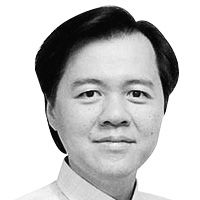Ampalaya for diabetics: Beginning evidence

My classmate Dr. Ricardo Quintos is a vascular surgeon at the National Kidney and Transplant Institute. He won the TOYM award a few years ago for his pioneering research work with his own inventions of stents for aortic aneurysms. Yes, you read it right, inventions like Thomas Edison’s. Dr. Ric also has a masters in medical education, and he’s an associate professor at the University of the
In his UP lab, Dr. Ric made it his personal mission to scientifically validate health claims of various herbs, from the lowly bawang to the high-profile virgin coco oil, as well as traditional medical practices, including the use of earthworms and maggots.
And so it comes as a delightful surprise that Dr. Ric has again made another pioneering research, but this time on diabetes. The scientific article is called, “Clinical Effects on Blood Glucose of a Herbal Combination of Mormodica charantia Linn, Lagerstroemia speciosa Linn, and Curcuma longa Linn.” In English, it means “How effective are ampalaya supplements in diabetic and normal patients.” This study I’ve got to see.
Diabetes Problem
In the
There are two types of diabetes. Type 1 diabetes is the insulin-dependent kind, which is due to an absence of or decreased production of insulin. Type 2 diabetes usually affects those 40 and above, and is called non-insulin-dependent diabetes. While modern medicine has offered remedies, diabetes cannot be cured, only controlled.
Three Ingredients
Dr. Ric tested the effect of ampalaya, banaba, and luyang dilaw on blood sugar levels. Ampalaya (Mormodica charantia) is a medicinal plant that has been recognized by the Department of Health. Its possible mechanism of action is the increased utilization of glucose by the liver. The plant insulin in ampalaya was identified as polypeptide-p, which apparently influences the regeneration of pancreatic beta cells, which secrete insulin.
Banaba (Lagerstroemia speciosa) is another medicinal plant claimed to help lower blood sugar and reduce weight. The active component is said to be corosolic acid, which promotes glucose transport.
Luyang dilaw (Curcuma longa Linn) has been used in traditional medicine for dyspepsia, flatulence, and abdominal pain, and as tincture for wounds. It is also believed to lower cholesterol and has antioxidants. Curcumin, a plant pigment, gives a distinct yellow color and is the primary substance of interest.
How good are these ingredients? I don’t know, but let’s see.
Results of the Study
Dr. Ric’s study includes 40 people. First, 20 individuals with type 2 diabetes were recruited with ages ranging from 41 to 63 years old. These patients have beginning complications of diabetes, such as nerve and blood vessel problems.
Second, another set of 20 individuals without diabetes was recruited, with ages ranging from 24 to 56 years old.
In both diabetic and non-diabetic groups, two stages of testings were done. In stage 1, a standardized meal was given first and blood sugar measured serially in 30-minute increments after the meal. In stage 2, ampalaya herbal capsules were given three times a day, and then blood sugar was checked serially.
The results: In the diabetic group, the average rise in blood sugar levels in patients taking ampalaya supplements were lower than those patients having diet alone. (Note: For researchers, it’s a significant statistical value.)
The healthy group taking supplements also showed a similar decrease in blood sugar levels, but it was still within normal limits. According to Dr. Ric, these supplements should be tested further in more patients to see if they can help prevent diabetes in susceptible individuals.
Benefits of Studying Ampalaya
Ampalaya fruit, leaves, and supplements may help lower blood sugar levels. In addition, there are several reasons to pursue studies on ampalaya.
1. Ampalaya has recently been listed by our Department of Health as one of 10 accepted herbal remedies.
2. Ampalaya and banaba are Filipino products, and can thus potentially help our economy. We can export these products.
3. Research studies on local products done by esteemed Filipino doctors should be encouraged and supported by our institutions.
The study is by no means a replacement for the big studies conducted by foreign drug companies on oral medications for diabetes. Dr. Ric stresses that these supplements are as described — supplements — and not replacements for their medications for diabetes. This is especially true for patients with very high blood sugar and those with serious complications. Consult your doctor.
However, there are some patients who are completely averse to taking Western medicines, and will try anything “natural.” For these patients, let’s keep an open mind for our very own ampalaya, banaba and luyang dilaw.
* * *
E-mail comments to drwillieong@gmail.com.



















